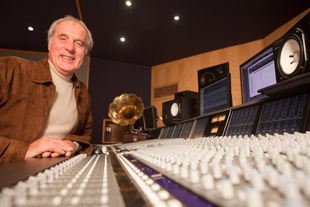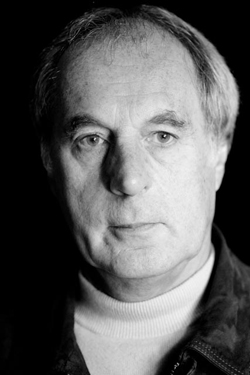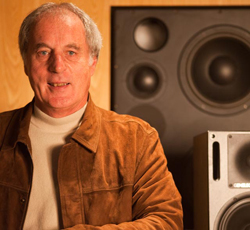![]() John Leckie has produced or engineered records for everyone who’s anyone in rock’n’roll. He’s picked up countless awards and accolades along the way, and been inducted into the Record Producers Hall of Fame by Led Zeppelin’s Jimmy Page.
John Leckie has produced or engineered records for everyone who’s anyone in rock’n’roll. He’s picked up countless awards and accolades along the way, and been inducted into the Record Producers Hall of Fame by Led Zeppelin’s Jimmy Page.
He has also been in the front line of just about every technological change to impact on the way music is recorded…
From Pink Floyd to the Simple Minds, John Lennon to Muse, Public Image Limited to XTC, Leckie has become one of the UK’s most successful record producers (selected discography).
With every change in recording and its attendant technologies he’s adapted and evolved, finding new ways to exploit emerging trends in both analogue and digital production. Leckie says that these days he doesn’t do interviews about his experiences with A-list clients. So when it comes to finding out more about what it’s like to work with the Stone Roses or Radiohead, ‘I’ve said everything I want to say.’
 But he’s not so reticent about the knobs and faders that have been his stock-in-trade for more than four decades. Sitting in one of the demo suites in Solid State Logic’s UK headquarters, he seems more than happy to chat about how all that’s changed.
But he’s not so reticent about the knobs and faders that have been his stock-in-trade for more than four decades. Sitting in one of the demo suites in Solid State Logic’s UK headquarters, he seems more than happy to chat about how all that’s changed.
‘I’ve been at this for 42 years, I think. I started at Abbey Road studios 15th February 1970.’ Although this date is clearly one burned into his memory, to understand the technological landscape he entered as one of EMI’s first hippie employees (‘I only got the job because I had long hair’) we need to go back a few years further.
At school, he ‘managed to get’ A-Levels in physics and geography (he was ‘useless’ at maths), before progressing to Ravensbourne College of Art in Bromley (where a young David Bowie did his foundation course.)
‘They’d bought four black and white TV cameras from Associated-Rediffusion that had just closed down. There were two courses running: an arts side, and I suppose a science side. The science people got in as technical operators and the others became producer/directors. My training there was setting up a four-camera TV studio, doing all the maintenance. This was all tube and valve equipment.’
By 1968 Leckie was writing a thesis on electronic music. ‘I was always mad keen on Moog synthesisers, or anything that was a new sound.’ Finding that there were very few books on the subject, Leckie copied notes from the back of Stockhausen sleeves. His thesis eventually covered all aspects of electronic music, from the design of oscillators and filters, to an appreciation of classical electronic music, taking in Pink Floyd and Jimi Hendrix along the way.
After a brief stint with a film company in a dubbing theatre, making industrial training films for Shell BP, it was time to move on. Unable to gain membership of the film union, the 19-year-old was stuck. Leckie wrote to all the big recording studios in London: EMI, Decca, ICP and Olympic. Only EMI replied, offering him an interview, and a few month’s later the lowly position of tape-op.
When Leckie arrived at Abbey Road, the set-up was based on 3M 8-track 1-inch tape machines with the legendary analogue TG consoles alongside them. In terms of outboard, there were ‘a few Altec compressors and Fairchild limiters. Microphones were by Neumann. I never saw a single Shure microphone, either an SM57 or SM58, until I left Abbey Road.’
Although EMI engineers had long given up the habit of wearing white coats, they still had clearly delineated roles, with job titles often containing the word ‘engineer’. Leckie remembers a strict regime: ‘Basically a tape-op’s job was to run the tape machine. Which was important because if you left the tape room, the session finished. But you didn’t set-up the studio. The Amp Room guys, who plugged everything in and did all the line testing, did that. The Balance Engineer did the session sheet, which was the layout for the orchestra and a mic list.’ Some of these layout sheets still exist, including those for Beatles’ sessions. Everything was analogue: ‘we simply couldn’t dream of anything else.’
Towards the end of his eight-year stint at Abbey Road, Leckie started to notice digital technology creeping into the mix. Change was rapid: mixing desks had gone from four channels to 16 – the Dark Side of the Moon desk was ‘considered huge’ – in the blink of an eye. With the 24-channe desk on the horizon, EMI simply couldn’t provide the technology to its global network of studios. The market erupted and the door was left wide open for a new generation of manufacturers such as SSL.
Times they are a-changin’
 Two major technological changes affected Leckie most as a producer. The first was simply the availability of more tape tracks to work with. To have a 24-track machine and to be able to slave together two of these ‘easily and reliably to produce 48-tracks was a big breakthrough’. This was market driven. Everyone knew this was coming, says Leckie. ‘When you were 8-track you always wanted nine. When you were 16-track you always wanted 17. And when you were 24, you always wanted 25 tracks. And so one of the turning points was access to more tracks. There’s always one more overdub, one more harmony.’
Two major technological changes affected Leckie most as a producer. The first was simply the availability of more tape tracks to work with. To have a 24-track machine and to be able to slave together two of these ‘easily and reliably to produce 48-tracks was a big breakthrough’. This was market driven. Everyone knew this was coming, says Leckie. ‘When you were 8-track you always wanted nine. When you were 16-track you always wanted 17. And when you were 24, you always wanted 25 tracks. And so one of the turning points was access to more tracks. There’s always one more overdub, one more harmony.’
This expansion was a two-edge sword, because ‘the fewer the tracks, the simpler it all was. And if you look at today, when there are an infinite number of tracks available, it’s all a bit silly. But at the time, this was the norm. It was a very complex system. But it was all you had.’
The second revolution was the advent of digital. ‘When I look at the big picture it’s strange really because in the 1960s and 70s, and even the 80s, there used to be an area of recording that was called semi-pro – essentially demo equipment and studios, where equipment was by manufacturers such as Tascam, Teac, Fostex, Akai… people like that. I’ve got nothing against this, but they weren’t professional. They weren’t Studer, Neumann, SSL or Neve.’ Over the years that distinction has blurred ‘because now you can have a pro recording studio in your bedroom.’
Did this frighten Leckie at all? ‘At first I stood aloof from this in the way a professional photographer with his Hasselblad would frown at taking pictures on an iPhone. But it’s the end result that counts. If a recording sounds good on the radio, it doesn’t matter if it was recorded at Air Studios or in someone’s bedroom.’
‘The other thing that’s changed,’ says Leckie, ‘is the way people listen to music.’ In the 1970s consumers were proud of their hi-fi systems. ‘I can remember inviting friends around to listen. It was, hey, let’s go around to John’s house and listen to the new Pink Floyd record there because he’s got great speakers.’
But it’s not like that any more: ‘There doesn’t seem to be the stimulus for people to listen on good speakers. Everyone listens on laptops, mobile phones, MP3 players. And, more people listen on headphones now.’ Does this cultural change in listening affect the way Leckie makes records today? ‘It should. But it doesn’t. I don’t mix records on iPod headphones.’
Making records
Leckie recalls that one of the main challenges of mixing for vinyl was the time limitation imposed by the format. In essence, the 33rpm ‘long player’ was a compromise format developed to allow record publishers to get an entire symphony onto one piece of plastic, allowing 22 minutes per side. This became the marker for modern musicians making LPs.
 ‘The problem was that there was always a fight to get more onto the record. If you had 26 or 28 minutes that you needed to get onto one side, then the level dropped. In other words, the challenge was to make the record sound loud.’
‘The problem was that there was always a fight to get more onto the record. If you had 26 or 28 minutes that you needed to get onto one side, then the level dropped. In other words, the challenge was to make the record sound loud.’
With the advent of the CD all this changed. Faced with potentially 80 minutes of uncompressed audio on one disc, recordings expanded to fit the space available. The resulting bonus tracks, disco remixes and various other filler did much to dilute the experience of listening to a conventional ‘album’.
‘That wasn’t really anything to do with the bands themselves,’ says Leckie. ‘It was more to do with the record companies asking for albums with 20 tracks on them.’ Every time a band went into the studio in the early days of CD, they were under pressure to record material of a length similar to the (much more rare) double studio album. ‘And for a while we lost the sense of a band making an album, as such.’
Was this a case of technology leading the creative process by the nose? Does Leckie miss the idea of deliberately sitting down with a band and making an LP-length record? ‘I still do that, actually. That’s what I aim for… to make a 10- or 12-track album.’
Artists in the house
Although we’re not here to talk about the household names that Leckie has produced, there comes a point where it’s impossible to go forward without discussing the human factor. Anyone who has even a passing interest in mainstream rock music in the 1970s, 80s, 90s and beyond will recognise the importance of Leckie’s work. But presumably, not all bands work the same way – so what happens creatively in between Day 1 and Day 30, from the band walking into the studio with an idea, to them walking out with a hit record. How much of a role does the producer play in the creative side?
At this point Leckie smiles knowingly before bursting into laughter. ‘You have to put in a lot of commitment. And the band has to be up for it. Very often records get difficult or even remain unfinished if one member of the band doesn’t really want to do it.’
The key is to start off positive and keep the ball rolling… ‘I very often say that a producer is the person who says something when the music stops. Invariably in the studio, the band’s going to play, or the singer’s going to sing, and you come to the end of the track. And there’s going to be silence. Everyone’s going to look around, waiting for someone to say something. And the person who speaks is the producer. Very often that’s the hardest part of the job.’
When it comes to details of his client-base, Leckie is discreet and diplomatic. Reading between the lines, there appear to be different levels of professionalism from band to band. ‘Of course, some need more encouragement and help than others,’ Leckie agrees. I ask him what were the best bands to work with: who are the ones that just walk in and nail it, when it seems like sitting on the riverbank with the fish jumping into your net? Leckie laughs again. ‘None of them. None of them are like that. But XTC are the most musical, imaginative, creative band you can get. They’re the funniest and the most serious, and the most rock’n’roll. Except they’re not rock’n’roll. They’re the ones that just get on and do it and the end result would be great. Whether it would be a hit or not…’
Back into the future
Having reflected on the pre-digital days and the key revolution of the increase in channel capacity, the discussion turns to the future. Once there were 120 recording studios in London. But now there are only three places where you can record a full orchestra. Despite the likes of SSL shipping big consoles in healthy numbers, the market for audio technology is changing and things are getting smaller.
But, Leckie thinks that all musicians aspire to working in big studios, recording their music on ‘big equipment with plenty of knobs and buttons, working on tape and hearing their creation reverberating around in a professional environment. On the other hand the future is going to be, for the most part, digital and miniature. We’re going to have mixing desks on iPad. All your plug-ins and software will be in the Cloud somewhere. The iPad will change a lot of things.’
Which is a long way from Abbey Road four decades ago, sweating over all those valves. Does John Leckie feel his was a privileged journey, or would he like to start all over again and just work in the digital domain? ‘It’s been a great privilege. I’m really pleased I’m not starting now. I became a producer through the engineering route and these days that would be a very difficult thing to do.’
A shorter version of this article first appeared in Engineering & Technology magazine’s December 2011 edition. Interview and portrait by Nick Smith.